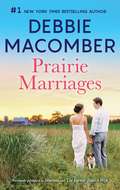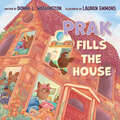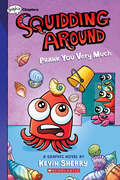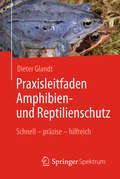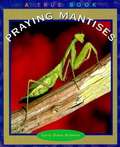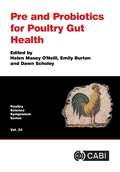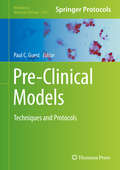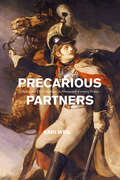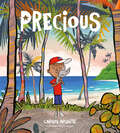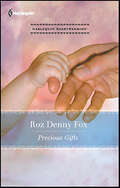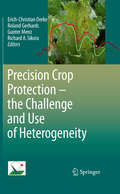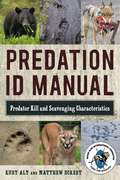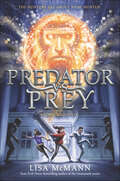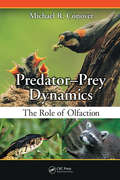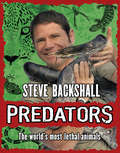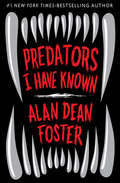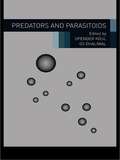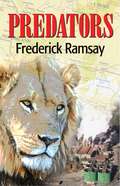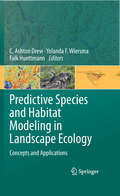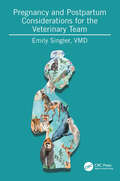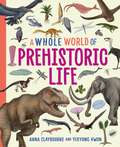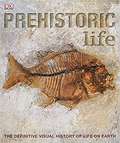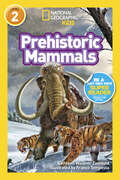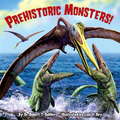- Table View
- List View
Prairie Marriages: A Bestselling Romance Anthology
by Debbie MacomberTogether for the first time in one box set, two classic Western romances from #1 New York Times bestselling author Debbie Macomber.MontanaFirst published in 1998Her grandfather wants her to come home, and Molly thinks she just might. His ranch will be a good place for her sons to grow up, a place to escape big-city influences. Then she learns—from a stranger named Sam Dakota—that her grandfather is ill. Possibly dying. Molly packs up the kids without a second thought and makes the long drive to Sweetgrass, Montana.Once she arrives, she immediately has questions about Sam Dakota. Why is he working on her grandfather’s ranch? Why doesn’t the sheriff trust him? Just who is he? But despite everything, Molly can’t deny her attraction to Sam—until her ailing grandfather tries to push them into marriage.Moving to the state of Montana is one thing; entering the state of matrimony is another! Some borders aren’t so easy to cross…Dakota FarmFirst published in 2012 as The Farmer Takes a Wife.Dave Stafford reckons he’s got enough to offer a woman: he’s decent and hardworking, and his farm in Buffalo Valley does all right. But there aren’t many women in town, so he places a personal ad. And he gets one single reply. Only Emma Fowler, a woman from Seattle, is interested. But when she arrives in North Dakota, she’s a little different from the picture she sent—and that’s not all Emma hasn’t been completely honest about. Emma is desperate to change her hectic, stretched-thin life, for her own sake…and for her three-year-old daughter. She’s been lonely, too, and is hoping that this practical match will be the solution for her bruised heart. Dave and Emma will discover they can make a family, once they get used to the fact that they are husband and wife!
Prak Fills the House
by Donna L. WashingtonThis hilarious retelling of &“The Three Little Pigs&” stars a spirited pig as she outsmarts her older siblings in a friendly competition.Prak is a practical pig who is often overlooked by her two older brothers: Mo the muscly one, and Bo the beautiful one. So when Poppa Pig offers his house to whichever of his children can fill it to the brim, everyone assumes Mo or Bo will be up for the task. No one expects Prak to have the strength or charisma to fill a house. But with a lot of creativity and a bit of luck, Prak might just surprise them all!Charming and lighthearted illustrations by debut illustrator Lauren Emmons joyously accentuate this lively read-aloud from the acclaimed author of Boo Stew, Donna L. Washington. A warm and endearing choice to share with family.
Prank You Very Much: A Graphix Chapters Book (Squidding Around #3)
by Kevin SherryThis wonderfully silly young graphic novel from Graphix Chapters about fin-tastic friends is perfect for fans of The Bad Guys and Narwhal and Jelly!Get drawn into reading with Graphix Chapters!Graphix Chapters are ideal books for beginning and newly independent readers aged 6-8. With approachable page counts, easy-to-follow paneling, and artwork that supports text comprehension, these engaging stories with unforgettable characters help children become lifelong readers.It's time for Seaweed Elementary's annual talent show, but Squizzard can't decide on an act. He's too distracted by the fact that it's also prank week! And he has some fin-tastically silly pranks planned. But his friends have a few tricks up their sleeves, and soon the joke is on Squizzard. Can he survive the prank war, or will he lose his crown as the reigning class clown fish once and for all?
Praxisleitfaden Amphibien- und Reptilienschutz: Schnell - Präzise - Hilfreich
by Martin Lay Dieter GlandtMit diesem handlichen Band werden Ihnen schnelle und zuverlässige Informationen in knapper übersichtlicher Form über alle mitteleuropäischen Amphibien- und Reptilienarten geboten.Frösche, Kröten, Unken, Molche, Salamander, Echsen und Schlangen in Deutschland, Österreich und der Schweiz werden behandelt. Dabei wird der Schwerpunkt auf die Gefährdung der Arten, deren Ursachen und besonders auf praktische Schutz- und Hilfsmaßnahmen gelegt.Studierende, freiberufliche Biologen, Landschaftsplaner und Naturschützer werden mit Gewinn dieses Nachschlagewerk bei Ihrer Arbeit nutzen. Interessierte Laien werden es gern in die Hand nehmen. Ziel der Maßnahmen soll sein, ein intaktes Netz in Verbindung stehender Populationen aufrecht zu halten oder dort, wo dies nicht der Fall ist, aufzubauen.Der Amphibien- und Reptilienschutz wird eingebettet in den Gesamtkomplex Naturschutz, wozu ein vorangestelltes allgemeines Kapitel dient. Verdeutlicht wird auch, dass diese Tiere einen wichtigen Stellenwert im Naturhaushalt (Stoffkreislauf) haben.
Praying Mantises: A True Book
by Larry Dane BrimnerDescribes the physical characteristics, behavior, life cycle, protective devices, and relatives of the praying mantis.
Pre and Probiotics for Poultry Gut Health (Poultry Science Symposium Series)
by Dawn Scholey Emily Burton Helen Masey O’NeillPoultry are the most widely used animal protein source in the world: billions of meat birds are produced globally each year, using 360 million tonnes of feed. Within Europe, over 30,000 companies involved in the production of poultry create an annual turnover of €107 billion. However, maintaining the sustainability of the industry as it moves towards antibiotic-free production is one of the key challenges. Starting with an overview of antibiotics as growth promoters and the challenges faced as the industry moves away from their use, this book then thoroughly considers the potential of pre and probiotic additives in poultry gut health. The book: - Includes thorough definitions of additives in the pre and probiotic space and examples of how they work; - Addresses how to test pre and probiotics and other similar additives, and how they interact with other products, with learning from both poultry and allied sectors; - Combines authors from both academic and industry backgrounds on all chapters, to ensure coverage is balanced, robust and commercially relevant. Based on the renowned World Poultry Science Association UK Branch Poultry Science Symposium 2022, this book provides a thorough and valuable contribution to the field for all involved with the nutrition and production of poultry.
Pre-Clinical Models: Techniques And Protocols (Methods in Molecular Biology #1916)
by Paul C. GuestThis volume details reviews and protocols on the development and analysis of both cellular and animal-based pre-clinical models in a number of medical areas, including metabolic disorders, longevity, cancer, heart disease and psychiatric disorders. Written in the highly successful Methods in Molecular Biology series format, chapters include introductions to their respective topics, lists of the necessary materials and reagents, step-by-step, readily reproducible laboratory protocols, and tips on troubleshooting and avoiding known pitfalls.Authoritative and cutting-edge, Pre-Clinical Models: Techniques and Protocols aims to provide methods that describe the context of specific disease or therapeutic areas.
Precarious Partners: Horses and Their Humans in Nineteenth-Century France (Animal Lives Ser.)
by Kari WeilFrom the recent spate of equine deaths on racetracks to protests demanding the removal of mounted Confederate soldier statues to the success and appeal of War Horse, there is no question that horses still play a role in our lives—though fewer and fewer of us actually interact with them. In Precarious Partners, Kari Weil takes readers back to a time in France when horses were an inescapable part of daily life. This was a time when horse ownership became an attainable dream not just for soldiers but also for middle-class children; when natural historians argued about animal intelligence; when the prevalence of horse beatings led to the first animal protection laws; and when the combined magnificence and abuse of these animals inspired artists, writers, and riders alike. Weil traces the evolving partnerships established between French citizens and their horses through this era. She considers the newly designed “races” of workhorses who carried men from the battlefield to the hippodrome, lugged heavy loads through the boulevards, or paraded women riders, amazones, in the parks or circus halls—as well as those unfortunate horses who found their fate on a dinner plate. Moving between literature, painting, natural philosophy, popular cartoons, sports manuals, and tracts of public hygiene, Precarious Partners traces the changing social, political, and emotional relations with these charismatic creatures who straddled conceptions of pet and livestock in nineteenth-century France.
Precious
by Carlos AponteThe heartwarming story of a boy, all the things he holds dear, and the song that inspires him when he needs it mostSometimes hearing a song gives you all the courage you need for a day. That&’s what happens to Pedrito after a hurricane howls through his neighborhood and he has to give up his rescue dog. The moment his big brother starts strumming &“Preciosa,&” a beautiful song about his beautiful island, Pedrito knows that somehow everything will be okay. . . .Pura Belpré Honor winner Carlos Aponte&’s love for Puerto Rico shines through his vibrant illustrations and touching story, which show the power of music and community to comfort and give strength.
Precious Gifts
by Roz Denny FoxThings have not gone well for Hayley Ryan. Her beloved grandfather is dead. Her ex-husband not only abandoned her for another woman but also stole Hayley's inheritance-and left her pregnant. All she has now is a piece of property to camp on-and a secret mine that might or might not produce.Jake Cooper is part owner of the Triple C Ranch in southern Arizona. Hayley Ryan's campsite is adjacent to the Triple C. The first time Jake rides into her camp, she points a shotgun at his head-and without even knowing it, takes aim at his heart....Jake is determined to persuade Hayley to trust him and marry him. As for Hayley's baby-to-be-he'd love the chance to be a dad!
Precision Crop Protection - the Challenge and Use of Heterogeneity
by Richard A. Sikora Erich-Christian Oerke Gunter Menz Roland GerhardsPrecision farming is an agricultural management system using global navigation satellite systems, geographic information systems, remote sensing, and data management systems for optimizing the use of nutrients, water, seed, pesticides and energy in heterogeneous field situations. This book provides extensive information on the state-of-the-art of research on precision crop protection and recent developments in site-specific application technologies for the management of weeds, arthropod pests, pathogens and nematodes. It gives the reader an up-to-date and in-depth review of both basic and applied research developments. The chapters discuss I) biology and epidemiology of pests, II) new sensor technologies, III) applications of multi-scale sensor systems, IV) sensor detection of pests in growing crops, V) spatial and non-spatial data management, VI) impact of pest heterogeneity and VII) precise mechanical and chemical pest control.
Predation ID Manual: Predator Kill and Scavenging Characteristics
by Kurt Alt Matthew EckertPart of the challenges and rewards of being a field biologist is being able recreate a predation event. But that experience is often difficult and frustrating, as time, weather, and other factors can be make clues sparse. Even the most careful of investigators can spend hours of time second-guessing themselves while exhausting every possibility from inconclusive evidence.The Predation ID Manual is designed to help assuage some of those difficulties by providing the reader with practical, expert advice, including:• A step-by-step approach for gathering evidence.• Suggestions of what to focus on at carcass site• A template of terminology to use when classifying a predation• A guide for investigating and determining signs of hemorrhage • Signs of kill and kill sites by species, including deer, elk, and lynx• And dozens more tipsWith a waterproof cover and sturdy pages, the SCIF’s Predation ID Manual is a must have for every serious hunter and field biologist.
Predator vs. Prey: Predator vs. Prey (Going Wild #2)
by Lisa McMannThe Avengers meets Animorphs in the second book of this epic series from Lisa McMann, New York Times bestselling author of the Unwanteds and Unwanteds Quests. “Kids will go wild for Going Wild!” raved Newbery Medal–winning author Katherine Applegate.The Going Wild series highlights the unbelievable (and completely true) abilities that animals possess, and it’s perfect for Marvel fans and middle grade readers who enjoy an exciting mix of action, humor, and heart. “Fans of Rick Riordan and Brandon Mull will not be disappointed,” proclaimed School Library Journal.In Predator vs. Prey, Charlie Wilde’s dad has been abducted by masked figures who might not even be completely human. And it will take more than her incredible bracelet—which gives her powers from the animal kingdom—to rescue him.Luckily, Charlie’s friends now have bracelets of their own with all-new abilities…they just have to work through a few issues first. Maria’s device has hair-raising side effects. Mac can’t wait to hack into his. And their frenemy, Kelly, swears hers is a dud. If Charlie is going to have any hope of saving her dad—and the world—from their beastly foes, she’ll have to help her friends master their powers and come together as a team.
Predator-Prey Dynamics: The Role of Olfaction
by Michael R. ConoverHumans, being visually oriented, are well versed in camouflage and how animals hide from predators that use vision to locate prey. However, many predators do not hunt by sight; they hunt by scent. This raises the question: do survival mechanisms and behaviors exist which allow animals to hide from these olfactory predators? If so, what are they, a
Predators
by Steve BackshallJoin DEADLY presenter Steve Backshall as he comes face to face with the world's deadliest animals, in a book packed with fascinating facts, killer statistics and stunning photographs. Combined with his own incredible experiences with creatures, large and small, Steve reveals tricks of camouflage, feats of strength, endurance, teamwork and speed, as well as giving us a glimpse into the lives of extremeophiles and looking at some of our planet's endangered species.
Predators
by Steve BackshallJoin DEADLY presenter Steve Backshall as he comes face to face with the world's deadliest animals, in a book packed with fascinating facts, killer statistics and stunning photographs. Combined with his own incredible experiences with creatures, large and small, Steve reveals tricks of camouflage, feats of strength, endurance, teamwork and speed, as well as giving us a glimpse into the lives of extremeophiles and looking at some of our planet's endangered species.
Predators I Have Known
by Alan Dean FosterAn adrenaline-fueled travel memoir of life in the wild among the planet&’s most ferocious and fascinating predators.Over the last forty years, New York Times–bestselling author Alan Dean Foster has journeyed around the globe to encounter nature&’s most fearsome creatures. His travels have taken him into the heart of the Amazon rain forest on the trail of deadly tangarana ants, on an elephant ride across the sweeping green plains of central India in search of the elusive Bengal tiger, and into the waters of the Australian coast to come face-to-face with great white sharks. Packed with pulse-pounding adventure and spiked with rapier wit, Predators I Have Known is a thrilling look at life and death in the wild.
Predators and Parasitoids (Advances In Biopesticide Research Ser. #Vol. 3)
by Opender Koul G. S. DhaliwalTheir natural enemies largely determine the population size and dynamic behavior of many plant-eating insects. Any reduction in enemy number can result in an insect outbreak. Applied biological control is thus one strategy for restoring functional biodiversity in many agroecosystems. Predators and Parasitoids addresses the role of natural enemies i
Predators: A Botswana Mystery (Botswana Series #1)
by Frederick RamsayLeo Painter is the CEO of Earth Global, a large energy, mining, and real-estate development firm. At the behest of the State Department, he and a party of company executives travel to Botswana, a country rich in extractable resources that Leo--and the U.S. government--would love to access. Traveling with him are his stepson and his wife, a woman with a past and a predilection for trouble. Sekoa is a male lion who shares with many of his bipedal enemies a form of HIV/AIDs. Weakened by the disease, he loses his place as the alpha male in his pride and now, dying and harassed by a pack of hyenas, seeks only a place to rest in peace. Like the lion, Painter is pursued by corporate "hyenas," and is searching for a place where he too can find some rest and build his dream: a resort and casino on Botswana's Chobe River.
Predictive Species and Habitat Modeling in Landscape Ecology
by Falk Huettmann Yolanda F. Wiersma C. Ashton DrewMost projects in Landscape Ecology, at some point, define a species-habitat association. These models are inherently spatial, dealing with landscapes and their configurations. Whether coding behavioral rules for dispersal of simulated organisms through simulated landscapes, or designing the sampling extent of field surveys and experiments in real landscapes, landscape ecologists must make assumptions about how organisms experience and utilize the landscape. These convenient working postulates allow modelers to project the model in time and space, yet rarely are they explicitly considered. The early years of landscape ecology necessarily focused on the evolution of effective data sources, metrics, and statistical approaches that could truly capture the spatial and temporal patterns and processes of interest. Now that these tools are well established, we reflect on the ecological theories that underpin the assumptions commonly made during species distribution modeling and mapping. This is crucial for applying models to questions of global sustainability. Due to the inherent use of GIS for much of this kind of research, and as several authors' research involves the production of multicolored map figures, there would be an 8-page color insert. Additional color figures could be made available through a digital archive, or by cost contributions of the chapter authors. Where applicable, would be relevant chapters' GIS data and model code available through a digital archive. The practice of data and code sharing is becoming standard in GIS studies, is an inherent method of this book, and will serve to add additional research value to the book for both academic and practitioner audiences.
Pregnancy and Postpartum Considerations for the Veterinary Team
by Emily SinglerPrecautions often apply to pregnancy in any workplace, but being a vet in practice presents additional specific risks. There are concerns and uncertainty about potential hazards, from radiation and inhalant anesthesia exposure, to zoonoses, and the additional mental stress in a profession that already carries high suicide risk. This book reviews considerations for professionals in clinical veterinary medicine (large and small animal) while pregnant and after giving birth. Veterinarian and veterinary writer, consultant, and mentor Dr Emily Singler speaks directly to veterinary team members (veterinarians, technicians, CSRs, assistants, students) who are pregnant or plan to become pregnant. She delivers scientific information on the specific risks to the mother and baby that may be encountered during pregnancy while working in veterinary medicine, with some of her own and others’ experiences to add perspective and humor. The book also covers topics related to mental health challenges, announcing a pregnancy and planning for parental leave, navigating the fourth trimester, and returning to work. We hope that having read this book, veterinary professionals – whether pregnant or working with pregnant colleagues – will feel better supported and empowered to make informed decisions.
Prehistoric Life (A Whole World of... #1)
by Anna ClaybourneGet lost in the diverse and bustling world of prehistoric life - with more to explore than you ever imagined!A Whole World of Prehistoric Life presents the stunning breadth of animal and plant varieties that filled prehistoric Earth. Which types of animal could swim or fly? When did flowers start appearing? Where do the dinosaurs fit into all of it? Which living things look familiar, and which look absolutely alien? This book has the answers and so many more facts filling the beautifully illustrated pages.A Whole World of is a book series looking at the extraordinary diversity of life on Earth - the defining features and evolutionary branches - and encourages readers age 7 and up to consider why it is important to maintain biodiversity. Written by award-winning author, Anna Claybourne, with artwork by award-winning illustrator, Yekyung Kwon.Books in the series:A Whole World of Mammals/A Whole World of Prehistoric Life/A Whole World of Minibeasts/A Whole World of Birds/A Whole World of Rocks and Minerals/A Whole World of Plants and Fungi
Prehistoric Life: The Definitive Visual History of Life on Earth
by Dorling Kindersley Publishing StaffWith an extensive catalog at its heart, Prehistoric Life profiles hundreds of fascinating species in incredible detail. The story starts in earnest 3.8 billion years ago, with the earliest-known form of life on Earth, a bacteria that still exists today, and journeys through action-packed millennia, charting the appearance of new life forms as well as devastating extinction events. Of course, the ever-popular and endlessly intriguing dinosaurs feature large, but Prehistoric Life gives you the whole picture, and the plants, invertebrates, amphibians, birds, reptiles, and mammals that are the ancestors of today's species also populate its pages, making this book unprecedented in its coverage of prehistory. <P><P>Specially commissioned artworks use cutting-edge technology to render species in breathtakingly realistic fashion, with astonishing images of prehistoric remains, such as skeletons and fossils, to complete the story. To put all the evidence in context, the concept of geological time is explored, as is the classification of species and how the evidence for their evolution is preserved and can be deciphered.
Prehistoric Mammals (Readers)
by Kathleen ZoehfeldFrom woolly mammoths to saber-toothed cats, prehistoric mammals once roamed Earth. With beautiful and engaging illustrations, authentic photos, and accessible text, kids will learn all about these mighty mammals in this level 2 reader.
Prehistoric Monsters! (Pictureback(R))
by Robert T. BakkerA super-simple introduction to prehistoric animals, from the first weird and wonderful life forms on Earth to the earliest Ice Age humans-and much, much more.
